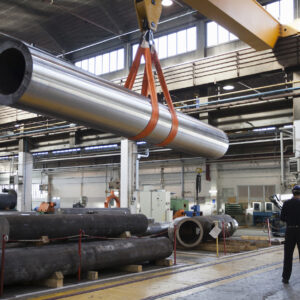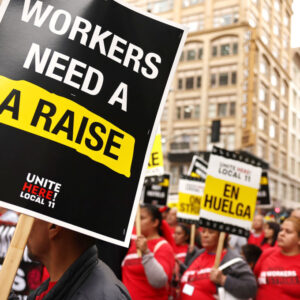Electric Vehicles: How Corporate Guardrails Can Improve Industrial Policy Outcomes
February 12, 2024
By Lenore Palladino
"While public investment is necessary for such a complex and urgent transformation of a major sector of the economy, the government’s engagement with the auto sector runs into a profound challenge: the shareholder primacy orientation in US corporate governance."
Introduction
Transforming the auto industry is a top goal for decarbonization: Transportation is the leading cause of greenhouse gas emissions in the United States, and cars emit half of transportation-related emissions (Cole et al. 2021). A major focus of US industrial policy, therefore, is shifting the auto industry from gas-powered to electric vehicles: The Biden administration has announced an ambitious target of 50 percent of new vehicle sales in the United States being zero-emission by 2030, and has put in place significant industrial policy efforts to redirect the US auto industry toward electric vehicle production (White House 2022). Public efforts require private auto manufacturers to change their production processes, but do not necessarily challenge their focus on shareholder value maximization, which has been detrimental to productivity, worker power, and the public interest for decades. This essay considers how past public policy toward the auto industry has supported the industry—even saving it from financial collapse—without shifting corporate practices, and how industrial policy should include corporate guardrails to maximize its success in the future.1 I make a set of discrete policy recommendations (which complement the focus on labor rights of the United Auto Workers [UAW] and other scholars) for worker voice in the production process, public equity stakes, and limits on corporate extraction.
The auto industry is a central force in the US economy. There are roughly 3 million workers employed throughout the US motor vehicles supply chain.
The auto sector has been an oligopolistic sector for decades—its structure has been “a group of large firms using similar technologies to produce new cars as competing products,” while also always relying on a system of suppliers and dealers (Froud et al. 2002). While the “Big Three” auto manufacturers—Ford, General Motors, and Stellantis—recognized the need for a transition to electric vehicles in the 2010s, the transition was sluggish (despite an Obama administration tax credit). The Biden administration has sought to dramatically speed up the transition. In January 2021, the day after the newly inaugurated President Biden signed a series of executive orders on climate change, General Motors announced its plan to exclusively offer electric vehicles by 2035 (Wayland 2021). The Inflation Reduction Act (IRA) included consumer tax credits for electric vehicles linked to domestic content requirements, stimulating demand as well as creating federal financing programs for auto companies to transition their manufacturing processes and build battery production facilities (Internal Revenue Service n.d.). The landmark industrial policy package that the Biden administration passed through Congress included $135 billion “to build America’s electric vehicle future, including critical minerals sourcing and processing and battery manufacturing” (White House 2022).2 The Department of Energy (DOE) announced the Domestic Conversion Grants Program—a $15.5 billion package of funding and loans “primarily focused on retooling existing factories for the transition to electric vehicles—supporting good jobs and a just transition to EVs,” which included $2 billion in grants and $10 billion in loans from the Inflation Reduction Act and $3.5 billion from the Bipartisan Infrastructure Law for domestic battery manufacturing (as well as funds to build out rapid charging infrastructure) (Department of Energy 2023a; Department of Energy 2023b).3 All of this support flows directly to the major auto manufacturers.
While public investment is necessary for such a complex and urgent transformation of a major sector of the economy, the government’s engagement with the auto sector runs into a profound challenge: the shareholder primacy orientation in US corporate governance. In previous work, I have described in detail how shareholder primacy is a flawed legal and economic theory for the corporation and how the decisions justified by corporate boards and managers have negatively impacted real investment, workers, and the public interest (Palladino 2019; Palladino 2021). Shareholder primacy, based on the neoclassical conception of perfectly competitive markets, defines the purpose of corporations as maximizing shareholder wealth, rather than producing goods and services for the benefit of multiple stakeholders (Froud et al. 2002; Ireland 2009; Lazonick and O’Sullivan 2000; Van der Zwan 2014). Rather than being a theory of production, it is a theory of allocation—the purpose of productive activity is to increase the wealth of shareholders. Over the last century, it grew various theoretical branches: As shareholders changed, the justification for shareholder primacy had to change as well. It answers the political economy question of who should have power over decision-making—shareholders—and who should control distribution and receive the gains of profits—also shareholders.4 For auto manufacturers, it has meant massive spending on stock buybacks. For example, GM announced a $10 billion authorization for stock buybacks in late November 2023 (about a quarter of its total market value), despite claiming in October that it could “not afford” the wage increases that striking auto workers were demanding (Shepardson 2023).5 This points to the challenges faced by an administration funding GM and other auto companies for the electric vehicle transition: There are currently no limits in place to ensure that companies do not simply use the public funding to increase their payments to shareholders.
Industrial policy has the ability to pair financial support for companies with “conditionalities” or “guardrails” to make sure that the public-interest purpose of public financial investment is met (Mazzucato and Rodrik 2023).
In this essay, I first describe how the auto industry bailouts that occurred during the financial crisis of 2008-2010 did not shift the company’s later behavior away from shareholder primacy but instead extracted concessions from the workforce at a substantial financial cost to the public—the opposite of how today’s proactive industrial policy should work. I then describe specific guardrails that complement the focus on maintaining a strong unionized workforce that the UAW and the administration have prioritized, including limits on corporate extraction, and mechanisms to bring worker voice into the “zone of entrepreneurial control,” i.e., business decisions, which unions cannot engage in under US labor law. Worker participation on corporate boards is standard in German auto manufacturing and also has a brief history in the US; I describe how encouraging such participation could again be a focus of US policymakers. Finally, I reflect on the public equity stake that the US government took during the auto sector bailout and how a proactive approach to holding an equity stake could support the goals of industrial policy moving forward.
While this essay focuses more narrowly on policy that affects auto manufacturers, it supports the premise that industrial policy should reduce individual vehicle dependence by supporting a strengthened public transit infrastructure. The market structure of the auto sector requires placing America’s dependence on cars within the broader context of our transportation infrastructure: As Freemark et al. (2022) have noted, “Americans collectively drive more than three trillion vehicle miles per year, most of those as a single driver in an automobile.” Public policy at all levels of government has created and sustained a car-based country, and the Bipartisan Infrastructure Law put substantial funds toward highway expansion even as it also sought to improve public transit. Though it is imperative to phase out gas-powered cars, it is also critical to reduce US household dependence on individual vehicles and build a robust public transportation infrastructure. 6
Auto Bailouts during the Financial Crisis
During the financial crisis and its recessionary aftermath, the federal government took equity stakes in troubled auto companies along with financial institutions.7 The Emergency Economic Stabilization Act of 2008 (EESA) Section 113 established the Troubled Asset Relief Program (TARP) and empowered the Treasury Secretary to purchase corporate equity in the interest of “stabiliz[ing] the financial system and restor[ing] confidence”; the $700 billion TARP asset purchase program included $125 billion of public equity stakes. TARP made the federal government a significant shareholder in GM, Chrysler, and GMAC (Black 2010).8 The GM bailout proceeded in several stages: First, the US Treasury provided $13.4 billion to GM in late 2008 as a loan, on the condition that GM restructure in exchange for warrants for 19.99 percent of GM’s outstanding common stock at the end of 2008 (with GM retaining the right to redeem the warrants or shares issued for the warrants once the loan was repaid) (Klingsberg, Tiger, and Bashman 2020). This loan did not turn out to be sufficient: By mid 2009, GM filed for bankruptcy. The US Treasury’s outstanding loans and warrants were converted into a 60.8 percent holding of GM’s outstanding stock, making it the majority shareholder, and GM delisted from the New York Stock Exchange. As the crisis abated, the federal government wound down its position as GM went public again through an initial public offering (IPO) in 2010, with GM using the proceeds of sales of stock in its IPO to repurchase shares from the US Treasury.
GM offers just one example of how the federal government could have approached the last decade differently with respect to companies bailed out during the financial crisis: the government could have been an active shareholder promoting the public interest. The federal government became the majority shareholder in GM during the collapse (bailouts to GM totalled $51 billion), and despite its enormous commitment to the company and its employees, sold the shares at a loss of $11 billion. By 2019, GM announced major closures9 despite robust profits. If the federal government had held onto its stake throughout the decade, it could have had a seat at the internal table for such discussions. GM has continued to spend billions of dollars on stock buybacks throughout the decade even while its efforts to transition to electric vehicles proceeded slowly (as described below) (Gilpin 2018; Bryant 2018).
The reality was that instead, the US Treasury described itself during the financial crisis as “reluctant shareholders,” (Office of Financial Research report cited in Black [2010], fn 19).10 As Black (2010) says, “there is no rule book for how the government should act as a shareholder,” so why has it acted as such an unwilling one even when its role was arguably far more crucial than other shareholders in times of crisis? Then-Treasury Secretary Larry Summers stated in 2007 that when the government acted as a shareholder, it would not necessarily act with pure shareholder primacy motivations—stating this as a reason for the government to not hold stakes (Backer 2008).11 By 2009, the Obama administration had pivoted from a formal, totally hands-off approach, as stated by Diana Farrell of the National Economic Council, to saying that “where the US government feels it is necessary to respond to a company’s request for substantial assistance, the government will reserve the right to set upfront conditions to protect taxpayers, promote financial stability and encourage growth,” (Davidoff 2010, p. 1757). Yet the goal was still to exit quickly.
The deals conducted by members of the Obama administration were largely made by officials who had previously worked as dealmakers in the financial sector (Davidoff and Zaring 2009). This dealmaking approach to the crisis meant that different institutions were dealt with differently and there was no consistent approach to what it actually meant for the government to take an equity stake—that is, how it would behave as a shareholder (Davidoff and Zaring 2009).12 While the EESA specified that the government could not vote as if it were a private shareholder, Davidoff (2010) concludes that the government did not make as strong a deal as a private entity would have. Likely because of political concerns, the federal government left economic returns on the table, enabling them to accrue privately rather than to the public interest. In other words, this meant that the government did not act, even though it was a significant shareholder, to make sure that the companies actually did the kinds of home loan modifications and small business investments that were necessary for the economic recovery and the public interest.
Labor was involved in the bankruptcy negotiations as a stakeholder, though the framework was not about improving conditions for the production workforce but instead about stabilizing the company in the interest of international competitiveness. The UAW agreed to concessions as part of the restructuring, including layoffs, wage freezes, and giving up cost-of-living adjustments; such concessions allowed GM to save $11 billion on labor costs (Hopkins and Lazonick 2023). In the 1980s and 1990s, unionized auto workers bargained for regular wage increases of 2.25 to 3 percent (or equivalent lump sum payments), but the 2003 agreement contained a two-year wage freeze and changes to cost-of-living adjustments to deal with rising health-care costs. In the next regular round of bargaining in 2007, the UAW traded off a pension increase for current members for the ability of the auto companies to create a new “tier” of workers whose wages were roughly half of the current workforce. By 2009, the UAW agreed to another round of concessions as part of bankruptcy negotiations with the federal government. According to economist Kristin Dziczek (2023) of the Federal Reserve:
A condition of the government assistance to Chrysler and GM was that they become “cost-competitive” with the international automakers that also produced light vehicles in the United States; this required closing a roughly $10 per hour labor cost gap with their international competitors. To do that, the UAW agreed to suspend the 2007 lump sums, COLA, and job security programs. Workers lost a holiday and their legal aid benefits, and older workers were offered buyouts and early retirement packages to make room for younger (and less costly) workers to be hired. The companies restructured their VEBA obligations by replacing cash commitments with equity. An additional provision mandated by the government was that the UAW could not strike until 2015.
In other words, the UAW became a significant shareholder of GM via its VEBA trust post-bailout. The negotiations set the stage for the next decade, because without the ability to strike, the 2011 contract contained few gains. By 2015, the top-tier legacy auto workforce received their first wage increases since 2006, while the entire workforce earned back some of the concessions made in earlier contracts. The 2019 bargaining led to a 40-day strike, resulting in another round of wage increases and increases for the second-tier workforce to bring them closer to parity with the top tier. Still, the concessions during the financial crisis are still felt by the long-term workforce; workers in 2023 remembered what happened in 2009: “‘We gave up a lot of concessions to help the corporation out,’ Nick, a 17-year UAW member at a Detroit plant, told me. ‘They promised us all these things back when brighter days came. It’s been a decade later and they still haven’t given us them back’” (Facundo 2023).
Policy Recommendations for Corporate Guardrails in the Electric Vehicle Transition
The industrial policy programs included incentives for high-road labor standards. For example, in the Domestic Conversion Grant Program, “higher scores will be given to projects that are likely to retain collective bargaining agreements and/or those that have an existing high-quality, high-wage hourly production workforce, such as applicants that currently pay top quartile wages in their industry,” which earned approval from the UAW (Department of Energy 2023a). The administration’s public statements about funding availability include consistent reference to “quality auto sector jobs” that remain in the communities in which they are currently located, in an explicit focus on the unionized facilities in the Midwest (Department of Energy 2023b). There is, in other words, an explicit focus on ensuring that factory conversions do not result in lower job quality.13
Works Councils and Worker Voice on Corporate Boards
The federal government could make a condition for financing that auto companies include a worker representative on their boards of directors and that they form worker councils at minimum for the purposes of considering health and safety issues.14 While industrial relations and worker representation on corporate boards—or “codetermination”—in the German auto sector have been the subject of extensive research, US labor and corporate law together shape consideration for how workers could participate directly in business decisions, in which labor unions are unable to engage under current law. “Works councils,” which also have an established presence in the international auto sector, are largely prohibited under US labor law in a well-intended restriction on company unions. However, former National Labor Relations Board (NLRB) Chair Wilma Liebman has clarified that such committees can be established for health and safety purposes (Liebman 2017). Policymakers should work in collaboration with the UAW to pursue appropriate mechanisms for workers to bring their expertise to the table for the benefit of the electric vehicles transition. In doing so, they can draw on previous US experience of auto union representation on the Chrysler board of directors.
The UAW negotiated for board representation at Chrysler in 1976 but was rebuffed by management until an economic crisis hit the company in 1980 (Fraser 1982; McGaughey 2019). In a 1982 article, Douglas Fraser, president of the UAW, outlined the experience that he had serving on the Chrysler board of directors as a representative of management: Because Chrysler had offered worker representation on the board to its unionized workforce in the UK, UAW workers in the US demanded it as well. As Fraser put it, the demand resonated among union employees because:
They reached the conclusion that they don’t have a voice in their own destiny and their own future unless they have representation at the point the decisions are made or before the decisions are made. Because once the decisions are made and once they are irreversible, you really can’t do anything about it. You can complain about it. But you can’t challenge it effectively. You have to be there, and you have to be a party to a decision or at least have a voice in the process of making the decision. (Fraser 1982)15
Chrysler rebuffed the demand until the 1979 union negotiations, when it nominated Fraser to the board of directors, to which he was elected with a statement to shareholders saying that he viewed his position as representing the workforce. He was able to bring the perspective of the workforce to the board on, for example, issues of the impacts of economic dislocation from plant closures, which “so many of the Board members ha[d] . . . never thought about before” (Fraser 1982).
Limits on Corporate Extraction
The administration should use its bargaining power vis-à-vis auto manufacturers to obtain commitments that funds will not be used for shareholder payments in the form of stock buybacks or excessive executive compensation, which is largely stock-based and affected by stock buybacks (Palladino 2019; Shilon 2021). The CHIPS and Science Act recognizes that restricting stock buybacks is important for taxpayer protection to fulfill the purposes of the Act. While the CHIPS Act stated that public funds could not be used for stock buybacks directly, money is fungible, so in order to make the restrictions meaningful, the CHIPS program office gives preference to companies that commit to not engage in stock buybacks. This is a clear model that should be used regarding IRA funds invested in the auto industry.
One agency that will play a key role in funding companies with IRA funds is the Department of Energy. Section 50142 of the IRA appropriates $3 billion to the Department of Energy to issue direct loans under §136(d) of the Energy Independence and Security Act of 2007.16 The loans are intended for the purpose of:
Reequipping, expanding, or establishing a manufacturing facility in the United States to produce . . . [or for] engineering integration performed in the United States of, advanced technology vehicles . . . [as defined in 42 U.S.C. § 17013(a)(1)] . . . only if such advanced technology vehicles emit, under any possible operational mode or condition, low or zero exhaust emissions of greenhouse gasses.
As the Department of Commerce did in the CHIPS Program Office Notice of Funding, the Department of Energy should preference corporations that commit to not conducting stock buybacks over the life of the loan (or at least commit to maintain them below certain predefined limits)—because this mitigates the risk that federal funds in effect subsidize stock buybacks. This would be in direct contravention of the purpose of the IRA (Dobbs-Allsopp, Palladino, and Shaw 2022). Other agencies engaged in grantmaking can use the same approach, given the overall productive purposes of the IRA. As in the CHIPS Act, once loans are granted there remains the question of what would keep companies from reneging on their commitments, in terms of their commitments to not engage in practices like stock buybacks or pay executive compensation based on stock price manipulation,17 and to actually make the long-term investments necessary to meet the productive goals of the public investment. While clawback mechanisms (i.e., enabling the government to recoup funds if the terms of the agreement are not met) may be difficult for conditional promises, companies that violate their commitments know that such behavior will be part of future federal funding evaluations.
Public Equity Stakes
Public equity stakes can be held by the federal government to engage directly in corporate decision-making. Acting as a shareholder, the federal government can vote on corporate decisions alongside other shareholders, and can in certain cases take a board seat, as many “activist” shareholders advocate for when they take major stakes. As described above in the case of the auto sector bailout during the financial crisis, historically, public equity stakes have been used in the United States for crisis management, when the federal government takes stakes in failing enterprises that are creating systemic risks (usually exiting the equity holdings as quickly as possible). The effects of government investment in businesses can never be predicted with certainty—by nature, the innovation process is full of risk. A public equity stake would function differently from a loan or grant in that it would enable the public to remain involved in the key choice points as businesses produce and innovate when a public investment has been made, making it possible—though not certain—that the public stakes contribute to the kinds of organizational capabilities that companies need to produce, rather than extractive corporate practices. A public equity stake gives the public a meaningful way to continue to engage when companies and projects have been deemed in the public interest such that they are worth public investment.
Public equity can contribute to changes in US corporate behavior and move companies away from the flawed decisions resulting from an excessive focus on shareholder primacy, though the substantive implementation questions for proactive public participation in corporate decision-making are manifold and likely would vary given the public policy goals of a given equity stake. When the government makes a financial investment in a business corporation, the government should participate in corporate governance by voting on major corporate decisions and holding a seat on the corporate board to ensure the public-interest goals of the investment are met. Public equity stakes could enable involvement in governance as a shareholder even without a board seat, including the ability to veto certain company actions, and accompany both economic and governance rights. Public equity stakes could mean the federal government receives a variable financial return on an investment. Shares could be held as a “golden share”—specific types of equity that only grant the government the right to vote on major corporate decisions such as dissolutions or mergers (Omarova 2017). The federal government could also hold shares as preferred stock, common stock, or a blend of the two. Equity stakes enable the government to fund a company while not adding liabilities to the government budget, and financial gains from a stake could be allocated to specific related projects or to the general fund.
Conclusion
As the foreword to this series of essays discusses, a more active economic “statecraft” is necessary for future industrial policy to be successful. The auto industry is central to the US decarbonization agenda and to the fortunes of the US manufacturing workforce. This essay addresses a question posed by Tucker: What institutions and strategies are missing from US industrial policy that could help it be more successful? It does so through looking at the history of US engagement with US auto companies and proposing a new institutional relationship moving forward. The Obama administration made major investments in the auto industry to stabilize it during the financial crisis, and the Biden administration has prioritized the transition of the auto industry in its industrial policy efforts. In order to ensure that public investment results in public gain, policymakers should use policy interventions to make the state an active participant in shaping the industry going forward by limiting extractive corporate financial practices, empowering the workforce in productive decisions, and participating directly in corporate governance.
___
The author thanks Roosevelt Institute staff; project participants; and Matt Hopkins and Bill Lazonick for their excellent feedback. The author would like to thank Todd Tucker for his comments and Sonya Gurwitt, Claire Greilich, and Sunny Malhotra for their editorial contributions.
Footnotes
Read the footnotes
1This essay builds on the analysis that Isabel Estevez and I offered in a 2022 Roosevelt Institute issue brief, “The Need for Corporate Guardrails in Industrial Policy.”
2The Environmental Protection Agency (EPA) has also proposed sweeping regulation to ensure that new cars produced and sold in the United States will be electric (Meyer and Pontecorvo 2023).
3The triumvirate of industrial policy projects include many efforts related to electric vehicles that are not discussed in this essay. For example, the Bipartisan Infrastructure Law invested $5 billion over five years in supporting states to develop the EV charging network through the National Electric Vehicle Charging Infrastructure Program (Joint Office of Energy and Transportation 2023). Other initiatives focus on reshoring the critical minerals—mainly lithium—required for electric vehicle production
4While this essay focuses on corporate guardrails in industrial policy, I have written elsewhere about the need to transform corporate and financial law across the entire economy, including in: “Towards ‘Accountable Capitalism”; “The Potential Benefits of a Public Asset Manager”; “Responsible Asset Managers”; and “Regulating Stock Buybacks.” The premise here is that while these broader changes are necessary, the political will is lacking, and industrial policy will be stronger if it includes changes that should eventually be applied economy-wide.
5This is after a 2015 fight with activist shareholder Harry Wilson in which GM committed to $5 billion in stock buybacks to keep Wilson off the GM board (Hopkins and Lazonick 2023).
6The Climate & Community Project’s “Toward a Green New Deal in Transportation” has an important set of recommendations to equitably decarbonize our transportation infrastructure (Freemark et al. 2022).
7For a complete description of public equity stakes taken during the financial crisis, see GAO 2010.
8For details on the actual number of shares held, see Black 2010.
9The announcement of plant closures made its stock price soar, in a clear example of the lack of a focus on production in the logic of shareholder primacy.
10Davidoff and Zaring (2009) describe the government’s role in the JPMorgan/Bear Stearns merger as “a deal-making middleman, a traditional role for investment bankers”
11The Treasury Managing Guiding Principles state, “we want to see the capital base of our financial system return to private hands as quickly as possible, while preserving financial stability and promoting economic recovery.” Guiding principles include:
– Protect taxpayer investments and maximize overall investment returns within competing constraints;
– Promote stability for, and prevent disruption of, financial markets and economy;
– Bolster market confidence to increase private market investment; and
– Dispose of investments as soon as practicable in a timely and orderly manner that minimizes financial market and economic impact (Black 2010).
This was not the first time the US government took public equity stakes: In 1984, “the FDIC took an 80 percent stake in a troubled bank, Continental Illinois, and held the stock for seven years before it divested. The FDIC was an active shareholder, though it was careful to distinguish its role as an active shareholder from nationalization: it recruited and selected the new CEO and Chair of the Board. The stock had no voting rights though they did have veto power over directors. The bailout cost the FDIC $1.1 billion” (Black 2010).
12From the DOE Loan Program Office’s description of its criteria: “In the event that an applicant seeks LPO financing for a project that converts or directly replaces an existing factory that has high-quality jobs, LPO will also assess the projected economic impacts of the facility conversion relative to the existing facility, including factors such as contribution to the local economy, employment history, anticipated employment, and duration of its existence For these projects, LPO will assess the degree to which the proposed project is likely to preserve high-quality jobs, prioritizing applicants that currently pay top quartile wages in their industry as reported by the US Bureau of Labor Statistics, as well as commensurate non-wage compensation benefits, as applicable. LPO will also consider the degree to which the proposed project, or group of projects, are in communities with a 20+ year history of producing vehicles or supplying parts for vehicles” (Department of Energy 2023b).
13For a complete analysis of how worker representation on corporate boards and works councils could function in the United States, see Palladino 2021.
14Fraser goes on to say: “I think representation on the Board, representation on all levels of the decision-making process will come about, will grow, because it’s the true spirit of democracy. In the final analysis, the companies are going to realize, as some of them have now, it’s good for all of us” (Fraser 1982).
16Inflation Reduction Act of 2022, Pub. L. No. 117-169, § 50142, 136 Stat. 1818, 2044 (2022); Energy and Independence and Security Act of 2007, Pub. L. No-110-140 § 136(d) (2007) (current version at 42 U.S.C. § 17013).
17See Hopkins and Lazonick (2023) for a full overview of executive compensation at GM and how CEO Mary Barra’s pay is actually influenced by the company’s moves to affect GM stock price.
References
Read the footnotes
Black, Barbara. 2010. “The U.S. as ‘Reluctant Shareholder’: Government, Business and the Law.” Entrepreneurial Business Law Journal 5, 561. https://heinonline.org/hol-cgi-bin/get_pdf.cgi?handle=hein.journals/eblwj5§ion=19.
Backer, Larry Catá. 2008. “The Private Law of Public Law: Public Authorities as Shareholders, Golden Shares, Sovereign Wealth Funds, and the Public Law Element in Private Choice of Law.” Tulane Law Review 82, no. 1 (May). https://papers.ssrn.com/sol3/papers.cfm?abstract_id=1135798.
Bryant, Chris. 2018. “Ford Gets Left at the Lights By General Motors.” Bloomberg, November 27, 2018, sec. Opinion. https://www.bloomberg.com/view/articles/2018-11-27/ford-gets-left-at-the-lights-by-general-motors.
Cole, Cassandra, Michael Droste, Christopher R. Knittel, Shanjun Li, and James H. Stock. 2021. “Policies for Electrifying the Light-Duty Vehicle Fleet in the United States.” Working Paper no. 2021-014. MIT CEEPR Working Paper Series. Cambridge, MA: MIT Center for Energy and Environmental Policy Research. https://scholar.harvard.edu/files/stock/files/policies_for_electrifying_the_light-duty_vehicle_fleet_in_the_united_states.pdf.
Davidoff, Steven M., and David Zaring. 2009. “Regulation By Deal: The Government’s Response to the Financial Crisis.” Administrative Law Review 61, no. 3 (Summer): 463–541. https://www.jstor.org/stable/40712060.
Davidoff, Steven M. 2010. “Uncomfortable Embrace: Federal Corporate Ownership in the Midst of the Financial Crisis.” Minnesota Law Review 95, 1733–78. https://heinonline.org/HOL/LandingPage?handle=hein.journals/mnlr95&div=42&id=&page=.
Department of Energy. 2023a. “Biden-Harris Administration Announces $15.5 Billion to Support a Strong and Just Transition to Electric Vehicles, Retooling Existing Plants, and Rehiring Existing Workers.” Department of Energy, August 31, 2023. https://www.energy.gov/articles/biden-harris-administration-announces-155-billion-support-strong-and-just-transition.
———. 2023b. “DOE Announces Availability of up to $10 Billion in Loan Authority for Automotive Manufacturing Conversion Projects to Retain Quality Auto-Sector Jobs.” Department of Energy, August 31, 2023. https://www.energy.gov/lpo/articles/doe-announces-availability-10-billion-loan-authority-automotive-manufacturing.
Dobbs-Allsopp, Will, Lenore Palladino, and Reed Shaw. 2022. “Limiting Stock Buybacks Among Recipients of Inflation Reduction Acts Funds.” Governing for Impact, December 2022. https://governingforimpact.org/wp-content/uploads/2022/12/IRA-Stock-Buybacks-PAM_templated_FINAL.pdf.
Dziczek, Kristin. 2023. “Recent UAW Contracts with Ford, GM, and Stellantis.” Federal Reserve Bank of Chicago, August 21, 2023. https://www.chicagofed.org/publications/blogs/chicago-fed-insights/2023/recent-uaw-contracts-ford-gm-stellantis#ftn2.
Facundo, Jarod. 2023. “The United Auto Workers Meet Electrification.” The American Prospect, August 21, 2023. https://prospect.org/labor/2023-08-21-united-auto-workers-meet-electrification/.
Fraser, Douglas A. 1982. “Worker Participation in Corporate Governance: The U.A.W.- Chrysler Experience.” Chicago-Kent Law Review 58, no. 4 (October): 949–80. https://scholarship.kentlaw.iit.edu/cgi/viewcontent.cgi?article=2461&context=cklawreview.
Froud, Julie, Colin Haslam, Sukhdev Johal, and Karel Williams. 2002. “Cars After Financialisation: A Case Study in Financial Under-Performance, Constraints and Consequences.” Competition & Change 6, no. 1 (January): 13–41. https://doi.org/10.1080/10245290212675.
Hopkins, Matt, and William Lazonick. 2023. “What the UAW and Everyone Else Needs to Know About CEO Pay.” Institute for New Economic Thinking (blog). October 2, 2023. https://www.ineteconomics.org/perspectives/blog/what-the-uaw-and-everyone-else-needs-to-know-about-ceo-pay.
Gilpin, Toni. 2018. “Socialize General Motors.” Jacobin, December 23, 2018. https://jacobin.com/2018/12/general-motors-united-auto-workers-closures.
Internal Revenue Service. n.d. “Credits for New Electric Vehicles Purchased in 2022 or Before.” Internal Revenue Service. Last updated November 29, 2023. https://www.irs.gov/credits-deductions/credits-for-new-electric-vehicles-purchased-in-2022-or-before.
Ireland, Paddy. 2009. “Financialization and Corporate Governance.” Northern Ireland Legal Quarterly 60, no. 1 (Spring): 15–34. https://nilq.qub.ac.uk/index.php/nilq/article/view/472.
Joint Office of Energy and Transportation. 2023. “Biden-Harris Administration, US Joint Office of Energy and Transportation Applaud Critical Milestone for SAE J3400 EV Charging Connector Standard.” Joint Office of Energy and Transportation, December 19, 2023. https://driveelectric.gov/news/j3400-ev-charging-connector-standard.
Klingsberg, Ethan, Paul Tiger, and Andrea Bashman. 2020. “Issuance of Equity to the US Government in Exchange for Aid—Considerations for Boards.” Harvard Law School Forum on Corporate Governance (blog). April 13, 2020. https://corpgov.law.harvard.edu/2020/04/13/issuance-of-equity-to-the-us-government-in-exchange-for-aid-considerations-for-boards/.
Lazonick, William, and Mary O’Sullivan. 2000. “Maximizing Shareholder Value: A New Ideology for Corporate Governance.” Economy and Society 29, no. 1 (December): 13–35. https://www.tandfonline.com/doi/abs/10.1080/030851400360541.
Liebman, Wilma B. 2017. “Does Federal Labor Law Preemption Doctrine Allow Experiments With Social Dialogue?” Harvard Law and Policy Review Online 12. https://journals.law.harvard.edu/lpr/wp-content/uploads/sites/89/2018/01/Liebman-Dialogue.pdf.
Omarova, Saule T. 2017. “Bank Governance and Systemic Stability: The Golden Share Approach.” Alabama Law Review 68, 1029. https://scholarship.law.cornell.edu/cgi/viewcontent.cgi?article=2634&context=facpub.
Mazzucato, Mariana, and Dani Rodrik. 2023. “Industrial Policy With Conditionalities: A Taxonomy and Sample Cases.” Working Paper Series (IIPP WP 2023-07). UCL Institute for Innovation and Public Purpose. https://drodrik.scholar.harvard.edu/sites/scholar.harvard.edu/files/dani-rodrik/files/conditionality_mazzucato_rodrik_0927202.pdf.
McGaughey, Ewan. 2019. “Democracy in America At Work: The History of Labor’s Vote in Corporate Governance.” Seattle University Law Review 42, 1–57. https://digitalcommons.law.seattleu.edu/cgi/viewcontent.cgi?article=2590&context=sulr.
Meyer, Robinson, and Emily Pontecorvo. 2023. “7 Big Takeaways from the EPA’s Electric Vehicles Push.” Heatmap News, April 12, 2023. https://heatmap.news/electric-vehicles/epa-car-emissions-evs-takeaways?rebelltitem=1#rebelltitem1.
Noble, Breana. 2023. “UAW Cheers DOE Grant That Gives Preference to Union, High-Paid Workforces.” The Detroit News, August 31, 2023, sec. Autos. https://www.detroitnews.com/story/business/autos/2023/08/31/uaw-energy-department-grant-preference-union-workforces/70731910007/.
Palladino, Lenore. 2019. “The $1 Trillion Question: New Approaches to Regulating Stock Buybacks.” Yale Journal on Regulation Bulletin 36, 89–106. https://www.yalejreg.com/bulletin/the-1-trillion-question-new-approaches-to-regulating-stock-buybacks-2/#:~:text=The%20%241%20Trillion%20Question%3A%20New%20Approaches%20to%20Regulating%20Stock%20Buybacks,-Lenore%20Palladino&text=Share%3A,market%20price%20for%20issuer%20securities.
Palladino, Lenore. 2021. “Economic Democracy At Work: Why (and How) Workers Should be Represented on Us Corporate Boards.” Journal of Law and Political Economy 1, no. 3: 373–96. https://escholarship.org/uc/item/4ks225mv.
Palladino, Lenore, and Isabel Estevez. 2022. “The Need for Corporate Guardrails in Industrial Policy.” Roosevelt Institute. https://rooseveltinstitute.org/publications/the-need-for-corporate-guardrails-in-us-industrial-policy/
Shepardson, David. 2023. “GM Sees $9.3 Billion Hit from Labor Deals, Outlines $10 Billion Stock Buyback.” Reuters, November 29, 2023, sec. Autos & Transportation. https://www.reuters.com/business/autos-transportation/gm-buy-back-10-billion-shares-cut-cruise-spending-2023-11-29/.
Shilon, Nitzan. 2021. “Stock Buyback Ability to Enhance Ceo Compensation: Theory, Evidence, and Policy Implications.” Lewis & Clark Law Review, no. 25: 303–59. https://law.lclark.edu/live/files/31608-10-shilon-article-251pdf.
US Government Accountability Office (GAO). 2010. Financial Assistance: Ongoing Challenges and Guiding Principles Related to Government Assistance For Private Sector Companies. GAO-10-719. Washington, DC: US Government Accountability Office. https://www.gao.gov/products/gao-10-719.
Van der Zwan, Natascha. 2014. “Making Sense of Financialization.” Socio-Economic Review 12, no. 1 (January): 99–129. https://academic.oup.com/ser/article-abstract/12/1/99/1704587?redirectedFrom=fulltext.
Wayland, Michael. 2021. “General Motors Plans to Exclusively Offer Electric Vehicles by 2035.” CNBC, January 28, 2021. https://www.cnbc.com/2021/01/28/general-motors-plans-to-exclusively-offer-electric-vehicles-by-2035.html.
White House. 2022. “FACT SHEET: Biden-Harris Administration Driving U.S. Battery Manufacturing and Good-Paying Jobs.” News release, October 19, 2022. https://www.whitehouse.gov/briefing-room/statements-releases/2022/10/19/fact-sheet-biden-harris-administration-driving-u-s-battery-manufacturing-and-good-paying-jobs/.
Explore the Series
The Role of State Ownership: Overview of State-Owned Entities in the Global Economy
by Kyunghoon Kim

Finance as a Tool of Industrial Policy: A Taxonomy of Institutional Options
by Saule T. Omarova
Leading With Industrial Policy: Lessons for Decarbonization from Swedish Green Steel
by Jonas Algers

Just Energy Transition in the Time of Place-Based Industrial Policy: Patch or Pathway to the Green Industrial Transformation?
by Andrea Furnaro
Fair Transition Funds, Employer Neutrality, and Card Checks: How Industrial Policy Could Relaunch Labor Unions in the United States
by César F. Rosado Marzán




